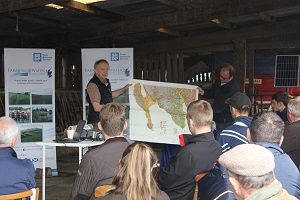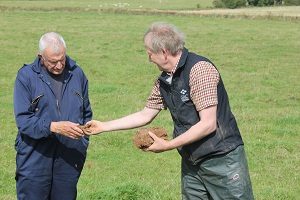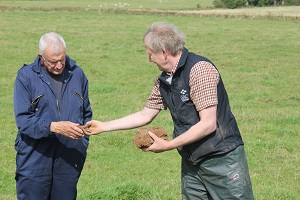Improving Drainage & Structure for Healthier Soils, Kilmarnock – event summary
24 August 2017Soil & drainage expert Seamus Donnelly as guest speaker
This meeting was held on 24 Aug 2017 at Lochhill Farm, Mauchline and kindly hosted by the Taylor family. Following a brief introduction and history of the farm, guest speaker Seamus Donnelly led the remainder of the meeting.
Seamus discussed how to go back to basics and check the soils maps for your farm and area. These maps can be accessed online here. Seamus also suggested that to understand the drainage on your farm, there should be drainage maps to refer to.
Practical discussions of assessing farm soils and drainage problems followed in the fields behind the steading. Seamus discussed common mistakes he has seen during his career with drainage systems that haven’t worked. He stressed the importance of digging a hole to understand what is going on in the soil. The group then dicussed how best they might drain the field. 
Later in the afternoon, Seamus gave a presentation about how to stop compaction occuring to begin with. before taking the group outside to see some machines in action that can remediate compaction. The merits of each were discussed before stressing the importance of knowing the depth of the problem and the correct conditions within which to use any equipment.
Key messages
- Dig a hole – it is the best way to assess soil structure and drainage.
- Consider the cost benefit analysis of draining land – would you be better off buying some more land instead?
- Before carrying out any work find out the soil type you are dealing with
- Make sure you have sufficient pipe size for the water flow.
- Make sure soil pH is correct – magnesium and calcium levels can affect the drainage of a soil
- Remove excess weight in the field on tractors, and look at spreading the weight over a larger surface area, either wider wheels or more axles
- Gravel up to the top soil – most drains fail as the water cannot get to them.
You can see the presentation slides that Seamus used throughout the day here & printed information available at the event is available to download below.
There are more photos from the event on our Facebook page.
- Farming For A Better Climate: Practical Guide – Alleviating Soil Compaction
- This Practical Guide gives some ideas on how to alleviate soil compaction.
- Topics: Soils
- Farming For A Better Climate: Practical Guide – Field Drainage
- Topics: Soils and Water Management
- Farming For A Better Climate: Practical Guide – Improving Soil Quality
- This Practical Guide concentrates on how we can improve soil quality to help us to adapt to climate change.
- Topics: Soils
- Farming For A Better Climate: Practical Guide – Soil Management
- Topics: Soils
- Valuing Your Soils – Practical Guidance for Scottish Farmers
- This brochure includes useful information about Scotland's agricultural soils and practical advice outlining the upfront financial savings and business benefits of better soil management and the efficient use of resources. Action and problem-specific 'field-sheets' are designed for busy farmers with limited time for reading.
- Topics: Climate Change, Soils, Water Management and Crops and Soils
- Visual Evaluation of Soil Structure (VESS) Score Chart
- This is a downloadable copy of the Visual Evaluation of Soil Structure (VESS) score chart for use in-field.
- Topics: Soils
- Assessing Soil Texture
- Topics: Soils
Sign up to the FAS newsletter
Receive updates on news, events and publications from Scotland’s Farm Advisory Service

